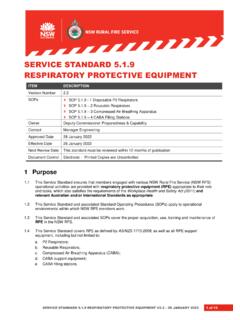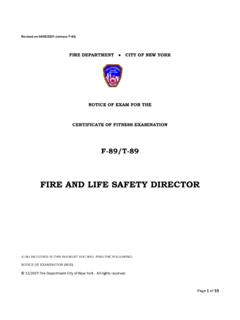Transcription of A Firefighter’s Guide to Foam
1 AFirefighter sGuidetoFoamNATIONAL s firefighter is faced with an increasing number of flammableliquid and hazardous vapor risks. Traffic accidents, rail disasters,industrial accidents, even a mishap at the local high school can resultin a flammable liquid or hazardous vapor incident. Until recently, mostof the training available to firefighters has focused on large volumeindustrial hazards. While these incidents are spectacular and devas-tating, their frequency is less common than the smaller incidentshandled every day, by local municipal fire Guide outlines the basic characteristics and types of foam as well as application hardware andproper application techniques. Utilizing this handy reference, you will begin to recognize the advan-tages and limitations of the wide variety of foams and equipment available and, more importantly,make informed choices when responding to a particular Foam has been on the cutting edge of the firefighting and fire protection industry develop-ing innovative solutions to challenging problems for over 170 years.
2 National Foam manufacturesthe most complete line of environmentally responsible foam concentrates, engineered foam sys-tems and foam apparatus. Our Feecon division with over 30 years of experience has been thepredominant leader in the development and manufacture of specialized airport foam firefightingequipment. Feecon products include turrets, nozzles, foam proportioning equipment and Training Program AvailableThe only TURNKEY flammable liquids training program on the market. Why develop your own programwhen the experts have done it for you? Use it as a canned program or dovetail it with your existing availability and pricing, contact your local National Foam distributor or call HOUR RED ALERT SERVICENATIONAL FOAM, Box 695, 150 Gordon DriveExton, PA 19341-0695Ph.
3 N D E XSUMMARY2 INDEX3 FOAM CONCENTRATES AND HOW THEY WORK4 FOAM TYPES5 FOAM CHARACTERISTICS7 FOAM PROPERTIES AND COMPARISONS7 FOAM PERCENTAGES PAIL LABELING7 BASIC GUIDELINES FOR FOAM8 HOW FOAM IS MADE8 PROPORTIONERS EDUCTORS9 AROUND THE PUMP SYSTEMS9 BALANCED PRESSURE PROPORTIONING10 FOAM NOZZLES10 APPLICATION RATES11 POST FIRE SECURITY12 APPLICATION TECHNIQUES13 CLASS A FOAMS14 CLASS A FOAM ADVANTAGES14 WETTING AGENTS15 HIGH EXPANSION FOAMS15 FOAM FIRE PROTECTION FOR OXYGENATED AND GASOLINE BLENDED FUELS16 FOAM CONCENTRATE COMPARISON CHART19 FOAM GLOSSARY20 FOAM CONCENTRATESFire-fighting foam is a stable mass of small bubbles of lower density than most flammable liquids and is a blanketing and cooling agent that is produced by mixing air into a foam solution that contains waterand foam RATESE xpansion rate is the ratio of finished foam producedfrom a volume of foam solution after being expandedfrom a foam making categorizes foam concentrates into three expan-sion ranges, as follows:1.
4 LOW EXPANSION Expansion ratio up to 20 designed for flammable liquids. Low ex-pansion foam has proven to be an effective meansof controlling, extinguishing, and securing mostflammable liquid (Class B) fires. Foam has alsobeen used successfully on Class A fires where thecooling and penetrating effect of the foam solutionis ConcentrateWaterAirMechanicalAgitationFO AMTETRAHEDRONS uppresses VaporFUELE xcludes OxygenVAPORSC ools2. MID-EXPANSION Expansion ratio from 20:1 to200:1. Medium expansion foams may be used tosuppress the vaporization of hazardous with expansions between 30:1 and 55:1have been found to produce the optimal foam blan-ket for vapor mitigation of highly water reactivechemicals and low boiling HIGH EXPANSION Expansion ratio above 200 Expansion foams are designed for confinedspace firefighting .
5 High expansion foam concen-trate is a synthetic, detergent-type foaming agentused in confined spaces such as basements,mines and ship board when used in combinationwith a High Expansion Foam FOAMS HOW THEY WORKFOAM EXTINGUISHES FLAMMABLE OR COMBUS-TIBLE LIQUID FIRES IN FOUR WAYS:1. Excludes air from the flammable Eliminates vapor release from fuel Separates the flames from the fuel Cools the fuel surface and surrounding TYPESThe following foam concentrates are the most commonly used today by firefighters. Protein Foam Concentrates Fluoroprotein Foam Concentrates Film Forming Fluoroprotein Foam Concentrates Aqueous Film Forming Foam Concentrates Alcohol-Resistant Foam Concentrates (AR-AFFF and AR-FFFP) Synthetic Detergent Foam (Mid and High Expansion)FuelFuelVAPORSP olymeric Membrane Formation Finished Foam5 PROTEIN FOAMR egular Protein foams (RP) are intended for use onhydrocarbon fuels only.
6 They produce a homoge-neous, stable foam blanket that has excellent heat re-sistance, burnback, and drainage Protein foams have slow knockdown charac-teristics; however, they provide superior post fire se-curity at very economical cost. Regular protein foamsmay be used with fresh or sea water. They MUST beproperly aspirated and should not be used with non-aspirating structural fog foams were the first types of mechanical foamto be marketed extensively and have been used sinceWorld War II. These foams are produced by the hy-drolysis of granulized keratin protein (protein hydroly-sate) such as hoof and horn meal, chicken feathers,etc. In addition, stabilizing additives and inhibitors areincluded to prevent corrosion, resist bacterial decom-position and to control FOAM (FP)Fluoroprotein foams have fluorochemical surfactantswhich greatly enhance performance with fast knock-down, improved resistance to fuel pick-up, and drychemical compatibility.
7 They are intended for use onHydrocarbon fuels and select oxygenated fuel addi-tives. As with Protein, they have excellent heat resis-tance, burnback, and post fire security. Fluoroproteinfoams may be used with fresh or sea water. TheyMUST be properly aspirated and should not be usedwith non-aspirating structural fog Foams are made by the addition of spe-cial fluorochemical surfactants to protein foam. Thisenhances the properties of protein foam by increasingfoam fluidity and improves the properties of regularprotein foam by providing faster knockdown and ex-cellent fuel FORMING FLUOROPROTEIN FOAM (FFFP)FFFP s are a combination of fluorochemical surfactantswith protein foam. They are designed to combine thefuel tolerance and burnback resistance of afluoroprotein foam with an increased knockdown foams release an aqueous film on the surfaceof the hydrocarbon FILM FORMING FOAM (AFFF)The National Foam AFFF family of foams are designedto provide the fastest possible knockdown on hydro-carbon fuels.
8 Their fluidity allows them to quickly flowaround obstacles, wreckage and debris. Different per-centages may be selected depending on the users pro-portioning hardware. Standard AFFFs are premixable,dry powder compatible, and can be used with eitherfresh or sea water. AFFFs may be used through non-aspirating devices, however,for optimum performanceaspirating nozzles should beused. Aer-O-Water 3 EMand 6EM conform to the fireperformance and chemicalformulation as defined byMILSPEC, cold foams havebeen specifically formulatedfor use in cold temperatureenvironments. They havethe same properties as regular AFFFs but have muchlower usable temperatures as seen below in the stor-age and handling s are a combination of fluorochemical surfactantsand synthetic foaming agents. AFFF s extinguish firesby forming a aqueous film.
9 This film is a thin layer offoam solution that spreads rapidly across the surfaceof a hydrocarbon fuel causing dramatic fire aqueous film is produced by the action of thefluorochemical surfactant reducing the surface tensionof the foam solution to a point where the solution canactually be supported on the surface of the RESISTANT AQUEOUS FILM FORMINGFOAM (AR-AFFF)Universal Plus is designed for use on Hydrocarbons@ 3% and Polar Solvents @ 6%. Universal Plus hasexcellent performance characteristics under a wide va-riety of conditions. Universal Plus is Dry Powder Com-patible and may be used with fresh or sea water. Whenused at 6% on Polar Solvents Universal Plus mustbe properly Gold 1/3% is designed to be used on Hydro-carbons and Polar Solvents @ 3%. Universal GOLD3% allows you to minimize your foam inventory re-quirements while maximizing extinguishing capabili-ties.
10 Universal GOLD 3% is Dry Powder Compatibleand may be used with fresh or sea water. When usedat 3% on Polar Solvents, Universal GOLD 3% mustbe properly resistant-AFFF foams are produced from acombination of synthetic detergents, fluorochemicalsand polysaccharide polymer. Polar solvents (or watermiscible) fuels such as alcohols are destructive to non-alcohol resistant type foams. Alcohol resistant-AFFF foams act as a conventional AFFF on hydrocarbonfuels, forming an aqueous film on the surface of thehydrocarbon fuel. When used on polar solvents (orwater miscible fuels), the polysaccharide polymerforms a tough membrane which separates the foamfrom the fuel and prevents the destruction of the foamblanket. While some concentrates are designed foruse on hydrocarbon fuels at 3% and polar solvents at6% , today s newer formulations are designed to beused at 3% on both fuel groups.

